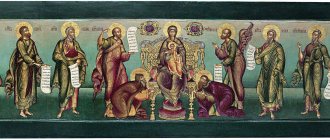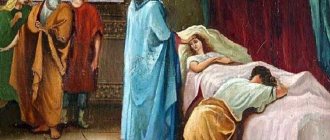Dangerous journey
A few weeks earlier, Jesus and His disciples had left Jerusalem. Here the Jews wanted to kill Jesus because He called himself the Son of God.
After crossing the Jordan, Jesus and his disciples settled for a time in an area called Gilead. At this time, trouble happened, which the messenger hastened to inform Jesus about. A friend of Jesus named Lazarus became seriously ill. Seeing that no ordinary medicines were helping, Lazarus’ sisters urgently equipped a servant and sent him across the Jordan to Jesus. After all, he could heal any disease - he restored sight to the blind, cleansed lepers and raised the paralyzed to their feet. Of course, it is now dangerous for him to return to the outskirts of Jerusalem. But Lazarus is his friend! Will Jesus not come to the aid of the one he loves so much?
Only at noon did the tired messenger reach the village where Jesus and the disciples were staying. But when he conveyed his sad news about Lazarus' illness, Jesus behaved strangely. Instead of immediately dropping everything and going to save his friend, He just said:
- This disease is not for death, but for the glory of God. May the Son of God be glorified through her.
The messenger was fed, then given a supply of water for the journey, and he set off on his way back. But Jesus remained where he was. The disciples did not say anything to Him about this.
Everyone understood: going now to Bethany, which was located next to Jerusalem, was mortally dangerous, because the Jews had not forgotten their decision to stone Jesus. However, two days later Jesus suddenly said:
- Get ready, we are going to Judea again.
The stunned students did not know what to answer to this:
- Teacher, how long have the Jews wanted to kill you? And now you are going there again...
Jesus explained:
— Our friend Lazarus fell asleep. I'm going to wake him up.
- If he fell asleep, it means that things are getting better, and he will soon recover. Why should we go there?
The disciples did not know that Jesus had received his sight in the spirit. Immediately after the messenger left Bethany, Lazarus died. And when Jesus said, “Lazarus fell asleep,” he was talking about his death. But seeing that the disciples did not understand Him, he said directly:
- Lazarus died. And I am glad for you that I was not there. Now you will believe that I am truly the Son of God. But enough talk. It's time to go. The students froze in indecision. And then one of them, named Thomas, realizing the danger their Teacher was exposed to, said:
“Let us also go and die with Him.”
The decision was taken. The disciples loved their Teacher, believed Him and accompanied Him wherever the path lay. Now they went with Him to where they were all going to be killed.
The resurrection of the stinking Lazarus: why did they organize the holiday “Lazarus Saturday”
What is death? Stopping the body from functioning? And does resuscitation give this life back? And what is life? Is life really interrupted by the death of the body? What is "resurrection from the dead"? Is there a difference between raising the dead and resurrecting him? And what is it, in one letter?
Lazarus Saturday answers all these fundamentally important questions, but Palm Sunday reminds us of the transience and frailty of everything earthly: greatness, glory. But about Palm Sunday and how easily a person changes his mind, in tomorrow’s article.
Today is about the resurrection of the dead, about Lazarus Saturday. So, who is Lazarus, whose name gave the name to the holiday of Lazarus Saturday? The story of Lazarus from Bethany, a village three kilometers from Jerusalem, is told in the Gospel of John, and it is told with such psychological precision, all the details are shown so visibly and vividly that you understand: the Evangelist John was inside the events, was a witness to the miracle that took place. The miracle of the resurrection of Lazarus. Usually they specify: “four-day Lazarus,” which means Lazarus who died four days ago. Yes, yes, the event that marked the beginning of the holiday called “Lazarus Saturday” is the resurrection of Lazarus, who died four days earlier and, as the Gospel honestly specifies, “already stinking.” That is, we are talking about the resurrection of the dead - precisely resurrection, and not resurrection, we will see what the difference is later.
But who was this Lazarus, to whom on the fourth day after his death Jesus Christ returned life, ordinary life in his physical, albeit already healthy, body? I will note in parentheses that, according to church tradition, Lazarus lived another 30 years after his resurrection, and then, like all people, he died - in the rank of Bishop of Kition, now the island of Cyprus. Well, at the time of his death, Lazarus was most likely a wealthy and absolutely revered Jew from Bethany. Friend of Jesus Christ - it is known that Jesus repeatedly visited the house of Lazarus and dined there with His disciples. Lazarus had two sisters - Martha and Mary, who also knew Christ well.
Now let’s turn to the Gospel of John and read it together with the holy fathers - the original source is more interesting than any retelling. Let me just remind you that the pronoun “He” and all its derivatives, written with a capital letter, are used in relation to the Son of God, the God-man, the Lord Jesus Christ.
“[At that time] a certain Lazarus from Bethany, from the village where Mary and Martha her sister lived, was sick. Mary was the one who anointed the Lord with myrrh and wiped His feet with her hair; her brother Lazarus was sick. The sisters sent to tell Him: “Lord! Behold, the one You love is sick.” Hearing this, Jesus said: “This sickness is not for death, but for the glory of God, so that the Son of God may be glorified through it.” Jesus loved Martha and her sister and Lazarus. And when he heard that Lazarus was sick, He remained for two days in the place where He was.”
Let's stop reading and think: why does Jesus hesitate when it comes to the fatal illness of his friend, the friend he loved? All the witnesses to this story asked themselves the same question two thousand years ago. The answer is simple. The holy fathers explain the delay of the God-man by the desire to resurrect a real dead man, four days old and stinking - a miracle unknown and unrepeatable to humanity before or after. “For this reason, Jesus delayed so that Lazarus would die and be buried, so that later no one could say that He raised him when he had not yet died, that it was only deep sleep, or relaxation, or deprivation of senses, but not death. For this reason, He remained for so long that even decay occurred, so that they said: He already stinks,” explains St. John Chrysostom.
We read further: “After this He says to the disciples: “Let us go again to Judea.” The disciples said to Him: “Rabbi! How long have the Jews been looking to stone You, and You are going there again?” Jesus answered: “Are there not twelve hours in the day? He who walks by day does not stumble, because he sees the light of this world; but whoever walks at night stumbles, because there is no light in him.” Having said this, he then said to them: “Lazarus, our friend, fell asleep; but I am going to wake him up.” His disciples said: “Lord! If he falls asleep, he will recover.” Jesus spoke about his death, but they thought that He was talking about a simple dream. Then Jesus said to them directly: “Lazarus is dead; and I rejoice for you that I was not there, so that you might believe; but let’s go to him.” Then Thomas, otherwise called the Twin, said to the disciples: “Come and we will die with Him.”
It’s as if we see Jesus’ disciples warning the Son of God: “Don’t go to Judea! They wanted to stone you there, but you go there again? Well, please, at least don’t go there during the day - it’s dangerous!” But Jesus answers them with a phrase that has not only a literal meaning, but also a deep theological one: “He who walks by day does not stumble, because he sees the light of this world; but whoever walks at night stumbles, because there is no light in him.” And now one of His disciples, Thomas, amazes us with his readiness to unconditionally, despite the dangers, follow Christ wherever He goes. By the way, this is the same unbelieving Thomas whom we will talk about a week after Easter, so let’s remember his determination today!
But let’s return to the Gospel text: “Jesus came and found that he (Lazarus) had already been in the tomb for four days. Bethany was near Jerusalem, about fifteen furlongs away; and many of the Jews came to Martha and Mary to console them in their grief about their brother. Martha, hearing that Jesus was coming, went to meet Him; Maria was sitting at home. Then Martha said to Jesus: “Lord! If You had been here, my brother would not have died. But even now I know that whatever You ask God for, God will give You.” Jesus tells her: “Your brother will rise again.” Martha said to Him: “I know that he will rise again on the resurrection, on the last day.” Jesus said to her: “I am the resurrection and the life; He who believes in Me, even if he dies, will live. And everyone who lives and believes in Me will never die. Do you believe this? She says to Him: “Yes, Lord! I believe that You are the Messiah (Christ), the Son of God, Coming into the world.” Having said this, she went and called Mary, her sister, saying secretly: “The Teacher is here and is calling you.” As soon as she heard, she quickly got up and went to Him. Jesus had not yet entered the village, but was at the place where Martha met Him. Then the Jews who were with her in the house and consoled her, seeing that Mary hastily got up and left, followed her, believing that she was going to the tomb to cry there. And Mary, coming to where Jesus was and seeing Him, fell at His feet and said to Him: “Lord! If You had been here, my brother would not have died.”
These dialogues between the sisters of the deceased Lazarus and Jesus Christ are extremely important. On the one hand, this is a kind of test by the Lord whether Martha and Mary are able to believe in the miracle of the resurrection, and, therefore, believe that Jesus standing before them is the Son of God. The sisters seem to believe, they themselves say: “If You, Jesus, who loves our brother so much, were here when he was just sick or just died, You would not have let him die, You would have resurrected him!”
But now it’s too late, they believe, decay, death, destroyed our brother, death has already won. Yes, as believing Jews, they know that someday their brother will rise from the dead, but now there is no longer life in him, but only corruption and death.
And here Jesus again utters words that are not entirely clear to the two grief-stricken women, words that have the deepest meaning: “I am the resurrection and the life; He who believes in Me, even if he dies, will live. And everyone who lives and believes in Me will never die. Do you believe this? And is it worth saying that these words are addressed not only to the grieving Martha and Mary, but to all of us?
And then something amazing happens. “When Jesus saw her (Mary) crying and the weeping Jews who came with her, He Himself was grieved in spirit and became agitated, and said: “Where have you laid him?” They say to Him: “Lord! Come and see." Jesus shed tears. The Jews then said: “Look how He loved him.” And some of them said: “Could not He, who opened the eyes of the blind man, have ensured that this one would not die?”
Why did Jesus cry? Knowing that Lazarus will be resurrected? God is crying! Knowing that death is subject to Him, he cries over the dead! Why? Why are we crying? When do we cry? When we have compassion for others! God weeps because He has compassion for His friend Lazarus! This moment of the Gospel is no less important than the fact of the resurrection itself! After all, he explains why God Jesus Christ Himself later accepted the Suffering of the Cross and Death. He did this out of compassion for us humans. Out of love.
But let's wipe away the tears. If we are precise, we will see: the Gospel does not say about the weeping Christ, and not even about the crying one, it says: “Jesus shed tears.” And this is also important. St. Basil the Great explains: Christ “confined the necessary passionate movements within a certain measure and limits, preventing lack of compassion, because this is bestial, and not allowing one to indulge in sorrow and shed many tears, because this is cowardly.”
Let us return again to the Gospel of John. “Jesus, again indignant within himself, comes to the tomb. It was a cave, and a stone closed it. Jesus says, “Take a stone.” The sister of the deceased, Martha, said to Him: “Lord! It already stinks; for it is already four days.” Jesus says to her, “Did I not tell you that if you believe, you will see the glory of God?” Then they took the stone, and Jesus looked up and said: “Father! Thank You that You heard Me. I knew that You would always hear Me; But I said this for the sake of the people standing around, so that they might believe that You sent Me.”
Having said this, He cried out with a loud voice: “Lazarus, come out!”
And the dead man came out, entwined on his hands and feet with burial cloths, and his face was tied with a scarf. Jesus says to them: “Untie him, let him go.” Then many of the Jews who came to Mary and saw what Jesus had done believed in Him.”
This imperious call of Christ: “Lazarus, come out!”, sounding in churches today, is addressed not only to Lazarus. Lazarus, a four-day inhabitant of the gloomy land of the dead, is the image of a soul buried under a shroud of sins, as one saint put it, a soul “smelling from our sins.” This call, heard even in the kingdom of the dead, should not become just words for us, still alive.
“Lazarus, come out!” flies through the millennia to us, even today. “Lazarus, come out!”, and the crypt is empty - the prison of our death. And the funeral shrouds, the bonds of our sin, lie around like helpless rags. “Untie him, let him go...” This is the scene that is depicted on the icon of the Feast of Lazarus Saturday.
But I promised to explain the difference between resurrection and resurrection from the dead. The resurrection of Lazarus is the return of the deceased, who “already stank,” to earthly life. And the Resurrection of the Dead, this is what Martha recalled, is the restoration of people’s physical bodies to a new state. Christianity teaches that everything must happen at the second coming of Jesus Christ. According to the Apostle Paul, the resurrection of the dead will happen “suddenly, in the twinkling of an eye, at the last trumpet; for the trumpet will sound, and the dead will rise incorruptible, and we will be changed in the twinkling of an eye.” The guarantee of this coming resurrection of the dead is the Resurrection of Christ on Easter. By his feat on the cross and death, and then resurrection, Jesus Christ transformed human nature and opened the path of resurrection to us, people.
Jesus Christ defeated death, and so, as a reminder to us that death has no power over the God-man, that He is stronger than death, the Church established a holiday called “Lazarus Saturday”, established it before Holy Week. On the day of Lazarus Saturday, fasting is even canceled; on this day, our ancestors always put fish caviar on the table - a product in past centuries that was more affordable than now. Can you guess why? There is so much depth and meaning in this, because the egg is the embryo of a new life, its rudiment. Notice how the most complex theology penetrated into the everyday life of believers and illuminated it.
And further. There is a joke floating around the Internet that explains exactly why the death of the body, perceived at the everyday level of consciousness as death in general, is not the end of life - the life of the individual, the life of the soul. This is not a finale at all. After all, if for some reason your friend lost his phone and therefore does not contact you, this does not mean that he, your friend, no longer exists?
Christ is crying
When they arrived in Bethany, they learned that Lazarus had been buried in a cave for four days (this is how the dead were buried in Judea). Many of the Jews came to Martha and Mary to console them in their grief about their brother. Martha, hearing that Jesus was coming, went to meet Him. Maria was sitting at home. Having met Jesus on the way to the village, Martha said:
- God! If You had been here, my brother would not have died. But even now I know that whatever you ask from God, God will give you.
Jesus answered her:
- Your brother will rise again.
“I know that he will rise again on the general resurrection of the dead, on the last day.”
Jesus said to her:
- I am the resurrection and the life; He who believes in Me, even if he dies, will live. And everyone who lives and believes in Me will never die. Do you believe this?
Martha did not fully understand what Jesus was saying. But she answered obediently:
- Yes, Lord! I believe that You are the Christ, the Son of God, coming into the world.
Having said this, she went and secretly called her sister Maria:
- The teacher is here and calling you.
The sisters did not want the Jews gathered with them to know about the coming of Jesus, because they were going to kill Him. Therefore, Mary, without explaining anything to anyone, hastily stood up and went to Him. But the Jews who were with her in the house and consoled her, seeing that Mary had gone out, followed her, believing that she had gone to the burial cave of Lazarus to cry there. Mary, coming to where Jesus was staying, fell at His feet and said to Him:
- God! If You had been here, my brother would not have died.
The Jews came after her, but when they saw Jesus, they did not attack him with stones. These were people who loved Lazarus very much and were now mourning their loss. Jesus, seeing the weeping Mary and the weeping Jews who came with her, Himself began to grieve and grieve. Addressing the sisters, He asked:
-Where did you put it?
The sisters replied:
- God! Come and see.
Then Jesus wept and went to the tomb of Lazarus.
The Jews, looking at Him, said:
- Look how He loved him...
However, some of them, even in such a difficult moment, could not restrain themselves from malice and said mockingly:
“Couldn’t this wonderworker, who opened the eyes of the blind man, have made sure that Lazarus did not die?”
Jesus, wiping away his tears, but continuing to grieve, came to the tomb. It was a cave, the entrance to which was blocked by a large stone.
Jesus, speaking to the Jews, said:
- Remove the stone.
The sister of the deceased, Martha, says to Him:
- God! There is no need to do this, because our brother has already died four days ago!
Jesus tells her:
“Didn’t I tell you that if you believe, you will see the glory of God?”
The Jews were at first outraged by these words. But then we decided: we’ll do as He says. If He doesn’t work a miracle, then we’ll stone Him to death right here.
They rolled the stone away from the cave where the deceased lay and began to wait to see what would happen next.
Manifestation of the Incarnation of Jesus Christ
Photo: Hram-olgi.ru
The resurrection of Lazarus not only gave people hope that earthly life is temporary and that we will all be resurrected at the command of Christ. This miracle showed the divinity of Jesus twice. When Lazarus died, the Son of God knew this, promising his disciples to show the real miracle of divine manifestation. Many did not understand this phrase, but Christ directly said that Lazarus died. At that moment, no one believed why He was saying this, until Jesus raised this dead man.
The second manifestation was that Jesus shed tears, which proved his true, and not ostentatious, Incarnation. John Chrysostom writes about this: “Why does the evangelist carefully and more than once notice that He wept and that He held back grief? So that you might know that He was truly clothed with our nature.” The Jews witnessed this event, although some doubted the divine essence of Christ. Subsequently, this doubt led to the fact that the Lord was crucified, because they did not believe and envied Him.
The miracle of the resurrection of Lazarus has a special, allegorical meaning for every Orthodox person.
Resurrection
Jesus had never been in such a position before. Very often performing miracles, He performed them, one might say, casually. And the more amazing they were, the less He collected witnesses for them and even sometimes forbade talking about them.
But now He had to perform the greatest miracle in front of a multitude of people. The beneficial impression from the previous miracles of Jesus could weaken over time, obscured by evil gossip spread by His opponents. On the other hand, the friends and admirers of Jesus were soon faced with the greatest temptation—His approaching suffering and death on the cross. Jesus knew that within just a few days He would die. How will His disciples take this? Won't they lose heart? Will they not disbelieve everything that He taught them for three years? Therefore, Jesus wanted to give his disciples a strong foundation of faith and a guarantee of hope that all things are possible with the Son of God. A tense silence hung in the air. The stone was rolled away, the black opening of the burial cave gaped like the mouth of some monster that had devoured Lazarus four days ago. And there was a crowd of Jews standing around, waiting to see what would happen next.
Jesus raised his eyes to heaven and said:
- Father! I thank You that You heard Me. I knew that You would always hear Me; but I said this for the sake of the people standing here, so that they might believe that it was You who sent Me.
Having said this, he called out in a loud voice:
- Lazarus! get out.
Sounds were heard from the tomb, as if someone was moving there. A moment later, the deceased Lazarus came out from there, wrapped in burial shrouds on his arms and legs, with his face bandaged with a scarf. Everyone present gasped and recoiled at this incredible sight. Horror and joyful admiration alternated between each other on their faces. Jesus turned to the astonished Jews and said:
- Untie him, let him go.
After this, many of the Jews who came to Mary and saw what Jesus had done believed in Him. And now popular rumor bears testimony to what happened from house to house, from village to village throughout the land of Judea. The history of their people carefully preserves cases when great prophets raised the dead. But no one has yet been able to resurrect a four-day old, already stinking corpse. Not otherwise, this Galilean preacher is truly the Son of God!
And at the same time, the Jewish high priests gathered for a council, deciding to kill along with Jesus Lazarus, whom He had resurrected...
***
Everyone went their own way in those days. Lazarus had to escape the insidious plan of the Jews, flee to the island of Cyprus, become a bishop there and die again in old age. Jesus walked towards suffering, death on the cross and the eternal glory of His Resurrection. His enemies are to the same eternal shame. Easter was approaching.
Take our short test and find out how well you remember the story of one of the most famous miracles of Jesus Christ - the resurrection of Lazarus!
Quiz
Test: How well do you remember the gospel story of Lazarus, Jesus' friend?
Start Quiz
Where was Lazarus, Jesus' friend, from?
From Jerusalem
From Bethany
From Nazareth
From Capernaum
Lazarus was born in Bethany. Christ stayed in this city on the eve of his triumphal entry into Jerusalem, and there the Savior performed a well-known miracle - he resurrected his friend.
Lazarus was born in Bethany. Christ stayed in this city on the eve of his triumphal entry into Jerusalem, and there the Savior performed a well-known miracle - he resurrected his friend.
Lazarus was born in Bethany. Christ stayed in this city on the eve of his triumphal entry into Jerusalem, and there the Savior performed a well-known miracle - he resurrected his friend.
Lazarus was born in Bethany. Christ stayed in this city on the eve of his triumphal entry into Jerusalem, and there the Savior performed a well-known miracle - he resurrected his friend.
What were the names of Lazarus' sisters?
Eve and Judith
Anna and Rachel
Martha and Mary
Sarah and Hagar
Martha and Mary are the sisters of Lazarus and are one of the most famous characters in the New Testament. Jesus Christ stayed in the house of these sisters. Both women witnessed the resurrection of their brother, performed by Christ at their request.
Martha and Mary are the sisters of Lazarus and are one of the most famous characters in the New Testament. Jesus Christ stayed in the house of these sisters. Both women witnessed the resurrection of their brother, performed by Christ at their request.
Martha and Mary are the sisters of Lazarus and are one of the most famous characters in the New Testament. Jesus Christ stayed in the house of these sisters. Both women witnessed the resurrection of their brother, performed by Christ at their request.
Martha and Mary are the sisters of Lazarus and are one of the most famous characters in the New Testament. Jesus Christ stayed in the house of these sisters. Both women witnessed the resurrection of their brother, performed by Christ at their request.
Where was Lazarus buried?
At the top of the Mount of Olives
On the shore of Lake Gennesaret
In the Jerusalem Temple
In a cave
Lazarus was buried in a cave according to Jewish custom. The entrance to the cave was covered with a large stone: “they took the stone away from the cave where the deceased lay. Jesus raised his eyes to heaven and said: Father! I thank You that You heard Me. I knew that You would always hear Me; but I said this for the sake of the people standing here, so that they might believe that You sent Me. Having said this, He cried out with a loud voice: Lazarus! get out. And the dead man came out, entwined on his hands and feet with burial cloths, and his face was tied with a scarf. Jesus says to them: Untie him, let him go” (Gospel of John, chapter 11).
Lazarus was buried in a cave according to Jewish custom. The entrance to the cave was covered with a large stone: “they took the stone away from the cave where the deceased lay. Jesus raised his eyes to heaven and said: Father! I thank You that You heard Me. I knew that You would always hear Me; but I said this for the sake of the people standing here, so that they might believe that You sent Me. Having said this, He cried out with a loud voice: Lazarus! get out. And the dead man came out, entwined on his hands and feet with burial cloths, and his face was tied with a scarf. Jesus says to them: Untie him, let him go” (Gospel of John, chapter 11).
Lazarus was buried in a cave according to Jewish custom. The entrance to the cave was covered with a large stone: “they took the stone away from the cave where the deceased lay. Jesus raised his eyes to heaven and said: Father! I thank You that You heard Me. I knew that You would always hear Me; but I said this for the sake of the people standing here, so that they might believe that You sent Me. Having said this, He cried out with a loud voice: Lazarus! get out. And the dead man came out, entwined on his hands and feet with burial cloths, and his face was tied with a scarf. Jesus says to them: Untie him, let him go” (Gospel of John, chapter 11).
Lazarus was buried in a cave according to Jewish custom. The entrance to the cave was covered with a large stone: “they took the stone away from the cave where the deceased lay. Jesus raised his eyes to heaven and said: Father! I thank You that You heard Me. I knew that You would always hear Me; but I said this for the sake of the people standing here, so that they might believe that You sent Me. Having said this, He cried out with a loud voice: Lazarus! get out. And the dead man came out, entwined on his hands and feet with burial cloths, and his face was tied with a scarf. Jesus says to them: Untie him, let him go” (Gospel of John, chapter 11).
How many days had Lazarus been dead when Christ came to him to resurrect him?
a week
Month
Four days
Three days
Lazarus of Bethany is also called Lazarus the Four Days (“Jesus came and found him already four days in the tomb”).
Lazarus of Bethany is also called Lazarus the Four Days (“Jesus came and found him already four days in the tomb”).
Lazarus of Bethany is also called Lazarus the Four Days (“Jesus came and found him already four days in the tomb”).
Lazarus of Bethany is also called Lazarus the Four Days (“Jesus came and found him already four days in the tomb”).
What is the future fate of Lazarus?
Preached Christianity in India and China
He was executed in 80, during the reign of the Roman Emperor Titus.
Became a preacher in Thessalonica and resurrected a little boy who died from a snake bite
Became a bishop in Cyprus and died in old age
After the Resurrection of Christ, Lazarus was forced due to persecution to leave Judea and move to Cyprus. He served as bishop there for 18 years. After his resurrection, he lived for another thirty years, and then died a second time in Cyprus in 63.
After the Resurrection of Christ, Lazarus was forced due to persecution to leave Judea and move to Cyprus. He served as bishop there for 18 years. After his resurrection, he lived for another thirty years, and then died a second time in Cyprus in 63.
After the Resurrection of Christ, Lazarus was forced due to persecution to leave Judea and move to Cyprus. He served as bishop there for 18 years. After his resurrection, he lived for another thirty years, and then died a second time in Cyprus in 63.
After the Resurrection of Christ, Lazarus was forced due to persecution to leave Judea and move to Cyprus. He served as bishop there for 18 years. After his resurrection, he lived for another thirty years, and then died a second time in Cyprus in 63.
Quiz
Be careful!
Our article about this famous miracle of Christ is very short, but very significant for the entire gospel history. We advise you to re-read it again!
A little bit lacking in attentiveness!
Looks like you missed some of our material! No problem, next time you will score maximum points!
Attentive reader!
Humanity still remembers the miracles of Christ, although two thousand years have passed since that time. You answered all our questions correctly! Congratulations!
Share the result:
The Raising of Lazarus is an Example for Our Faith
Important!
Although Jesus Christ knew very well that God the Father wanted to raise Lazarus from the dead through Him. His human experiences were trying to take over. And so that these experiences would not have a negative impact on the faith of Jesus Christ, He did not look at the deceased, but raised His gaze to heaven to the Father. This is a great example for our faith!
While we look at a problem or illness, it seems big and insoluble to us. When we turn our gaze to Jesus Christ by faith, God gives the answer and performs miracles! And for this we have a basis in Scripture: “Looking unto Jesus, the author and finisher of our faith, who for the joy that was set before Him endured the cross, despising the shame, and is seated at the right hand of the throne of God.” (Hebrews 12:2)
The Greek word for "perfector" is: "τελειωτής - teleiotes." Means: completer, completer, implementer.
Greek legend says that after the resurrection, Lazarus lived for 30 years, after which he died in Cyprus
After the resurrection of Lazarus, the holiday of the Jewish Passover was approaching, after which the last days of the earthly life of Jesus Christ began.
About the life of the righteous Lazarus, a later Greek legend reports that after his resurrection, Lazarus lived for another 30 years. He became the Bishop of Kitia on the island of Cyprus, where he later died.
Lazarus fell under the persecution of the Jerusalem church, which began after the murder of the first martyr Stephen.
The relics of righteous Lazarus were found in 890 in the city of Kitia.
He, along with another saint, was expelled from Judea and put out to sea on a boat without oars, which then sailed to Cyprus. There Lazarus and the apostles preached the teachings of Christ.
According to Orthodox tradition, the relics of the righteous were found in 890 in the city of Kitia. In 898, the relics of Lazarus were transferred to Constantinople, where they were placed in a temple in the name of St. Lazarus.









